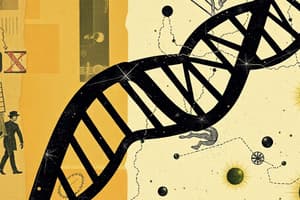Podcast
Questions and Answers
What initiates DNA synthesis in prokaryotic replication?
What initiates DNA synthesis in prokaryotic replication?
- DNA polymerase III
- Primase synthesizing RNA primers (correct)
- Single-stranded binding proteins
- Helicase enzymes
Which enzyme joins the Okazaki fragments in prokaryotic DNA replication?
Which enzyme joins the Okazaki fragments in prokaryotic DNA replication?
- DNA polymerase I
- Helicase
- Primase
- DNA ligase (correct)
How is replication initiated in eukaryotic cells?
How is replication initiated in eukaryotic cells?
- At multiple origins of replication (correct)
- After the chromosome is completely unwound
- At a single origin of replication
- Randomly throughout the genome
What type of DNA structure is present in prokaryotes?
What type of DNA structure is present in prokaryotes?
How does the process of DNA replication differ between prokaryotes and eukaryotes?
How does the process of DNA replication differ between prokaryotes and eukaryotes?
What is the role of DNA polymerase I in prokaryotic replication?
What is the role of DNA polymerase I in prokaryotic replication?
What happens to the DNA after replication in both prokaryotes and eukaryotes?
What happens to the DNA after replication in both prokaryotes and eukaryotes?
What feature facilitates the separation of double-stranded DNA during eukaryotic replication?
What feature facilitates the separation of double-stranded DNA during eukaryotic replication?
Flashcards
Replication
Replication
The process by which a cell duplicates its genetic material.
Origin of Replication
Origin of Replication
A specific site on a circular DNA molecule where replication begins in prokaryotes.
Helicase
Helicase
An enzyme that unwinds the DNA double helix to separate the strands.
Single-stranded Binding Proteins
Single-stranded Binding Proteins
Signup and view all the flashcards
Primase
Primase
Signup and view all the flashcards
Leading Strand
Leading Strand
Signup and view all the flashcards
Lagging Strand
Lagging Strand
Signup and view all the flashcards
Origin Recognition Complex
Origin Recognition Complex
Signup and view all the flashcards
Study Notes
Replication in Prokaryotes
- Replication begins at a specific site on circular DNA called the origin of replication
- DNA unwinds and separates via helicase
- Single-stranded binding proteins stabilize single-stranded DNA
- Primase synthesizes RNA primers to initiate DNA synthesis
- DNA polymerase III adds nucleotides to the 3' end of the RNA primer for the new strand
- DNA polymerase I removes RNA primers and replaces with DNA
- Leading strand is synthesized continuously; lagging strand is synthesized in short Okazaki fragments
- Okazaki fragments are joined by DNA ligase
Replication in Eukaryotes
- Replication is more complex and highly regulated
- DNA is linear and packaged into chromatin
- Chromatin must be unwound and replicated in a coordinated fashion
- Replication begins at multiple origins of replication throughout the genome
- Origin recognition complex (ORC) recognizes and binds to origins
- Helicase unwinds DNA at each origin, forming replication bubbles
- DNA synthesis on the leading strand is continuous; lagging strand is synthesized in Okazaki fragments
- RNA primers are removed, and fragments are joined by DNA ligase
- Result is two identical linear DNA molecules, each packaged into a chromosome
Studying That Suits You
Use AI to generate personalized quizzes and flashcards to suit your learning preferences.




